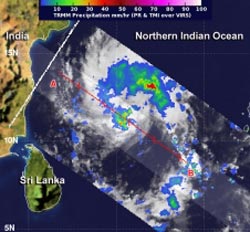NASA Sees a Re-Awakening of Ex-Depression 30W in a Different Ocean

NASA's TRMM satellite saw heavy rain, rain falling at a rate of over 50 mm/2 inches per hour northeast 30W's center (red). Thunderstorms in that quadrant were as high as 10 km/6.2 miles high. Image Credit: SSAI/NASA, Hal Pierce<br>
Ex-tropical storm 30W is currently a low pressure area located near 12.0 north and 84.5 east, approximately 250 nautical miles east-southeast of Chennai, India.
30W had maximum sustained winds as high as 30 knots/34.5 mph/55.5 kph, so it's on the edge of tropical depression status. The low is moving to the west-southwest at 9 knots/10.3 mph/16.6 kph and expected to continue in that direction until it makes landfall.
NASA's Tropical Rainfall Measuring Mission or TRMM satellite captured imagery that showed areas of heavy rain, rain falling at a rate of over 50 mm/2 inches per hour, were occurring northeast of the center of circulation. Thunderstorms in that quadrant were as high as 10 km/6.2 miles high. Satellite data also showed the bands of thunderstorms had developed around the center of circulation.
Warnings have already been posted along the coast of southeastern India as the re-developing low with heavy rain is expected to make landfall in the next day or two. By Friday, Nov. 15, heavy rainfall of up to 10 inches is expected over northern Tamil Nadu and southern Andhra Pradesh.
The low pressure area is expected to continue tracking to the west-southwest and approach southeastern India and northern Sri Lanka in the next two days and has a high chance of making landfall at least as a tropical depression.
Text credit: Rob Gutro
NASA's Goddard Space Flight Center
Media Contact
All latest news from the category: Earth Sciences
Earth Sciences (also referred to as Geosciences), which deals with basic issues surrounding our planet, plays a vital role in the area of energy and raw materials supply.
Earth Sciences comprises subjects such as geology, geography, geological informatics, paleontology, mineralogy, petrography, crystallography, geophysics, geodesy, glaciology, cartography, photogrammetry, meteorology and seismology, early-warning systems, earthquake research and polar research.
Newest articles

Properties of new materials for microchips
… can now be measured well. Reseachers of Delft University of Technology demonstrated measuring performance properties of ultrathin silicon membranes. Making ever smaller and more powerful chips requires new ultrathin…

Floating solar’s potential
… to support sustainable development by addressing climate, water, and energy goals holistically. A new study published this week in Nature Energy raises the potential for floating solar photovoltaics (FPV)…

Skyrmions move at record speeds
… a step towards the computing of the future. An international research team led by scientists from the CNRS1 has discovered that the magnetic nanobubbles2 known as skyrmions can be…




















